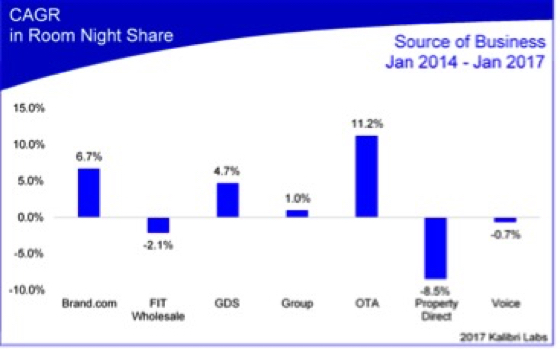Benchmarking is a hallmark of performance measurement. Knowing where a hotel falls in relation to the performance of its closest competitors is an important first step toward improving its business and profitability. Identifying which property in a comp set is making the most money is an important part of the equation but not the ultimate question. Understanding the demand drivers that are fueling the performance of the top hotels in the comp set with the goal of developing a distribution strategy to tap into that demand are the key components of benchmarking.
Demand for a hotel comes through various distribution channels. The first step in developing a distribution strategy is to understand the costs associated with each channel, including costs that may not appear on the hotel’s profit and loss statement. For example, although the commission taken from Guest-Paid Revenue for guests who book through wholesale or net-rate channels does not appear as an accounting cost to the hotel, these hidden costs should nonetheless be considered as such because they represent real, foregone cash the hotel could have earned if the guest had booked through a different channel. In 2016, the revenue difference between what guests paid and what hotels across the industry in the U.S. collected was approximately US$1.8 billion.
Forecasting demand by channel is another important step as each channel may vary significantly from the others. As seen in the chart here, from January 2014 to January 2017, Brand.com experienced a compound annual growth rate (CAGR) of 6.7%, while Property Direct experienced a CAGR of -8.5%. While Property Direct may result in a more profitable guest, relying too much on Property Direct business as part of the hotel’s distribution strategy may not be the most effective recommendation for a hotel. However, to know what is best for a specific hotel, further analysis is needed.

Examining the nature of each channel with respect to acquisition, conversion, and retention of guests should also go toward determining a hotel’s optimal channel mix and revenue performance. Although, simply increasing reliance on low-cost channels may be tempting, shifting demand to a higher-cost channel may be more beneficial for a hotel, if the higher-cost channel routinely results in repeat guests.
It’s only after the costs, growth, and nature of each distribution channel are well understood can a hotel develop a realistic and achievable distribution strategy that will result in its optimal channel mix and improve its ranking within its comp set.
Contributed by Ankush Khullar, data strategy and research analyst, Kalibri Labs
